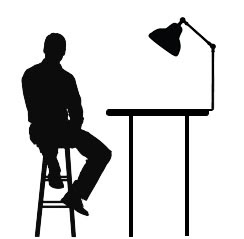FIGURE ONE: Lefteri, C (2014) Materials for Design
In the introduction of Chris Lefteri's 'Materials for Design' (2014), he mentions a specific point.
"- the information that you receive on your phone, laptop, TV, or the increasing number of other screen-based electronic devices will change the physical interaction you have with materials rather than change the way they look"
This point alone, is enough to make designers think about the impact that technology has/is/will have on our connection with our surrounding environment. For example, 'screen-based electronic devices' are the main reason as to why many people ignore the beautiful buildings, landscape and people around them, however with the aid of designers, there could potentially be a material/product/service that can help bring the best combination forward; 'Technology and genuinely curious people'. Meaning that people can enjoy using technology just as much as they previously would, but it would also help them look at certain mundane tasks in a different way
GROWN
In this chapter of the book Lefteri, talks about materials that all natural, 'fish leather, textiles created from bacteria and horsehair, plastic made from chicken feathers, and the more usual grown materials such as plant fibres and wood.'
OIL BASED
In this chapter, Chris ventures to talk about all forms of plastics and how over the years they have slowly changed from Bakelite and are now currently as intriguing as ever and can be made in different ways. E.g Thermosetting and thermoplastics.
MINED
Within this chapter Lefteri, mentions materials like Glass, Metal (alloys and ores) and Ceramics and many, many other materials that are also extracts from the ground/Earth.
Taking into consideration the point mentioned above about screen-based technology changing our physical reactions with materials; I designed a table that can allow the user work with ease at this station. Mainly by providing them with the usual task lighting so that they are able to work with efficient lighting, however in this case, I designed a table where the table can sense exactly which part of the table the user is working from, and then the desk lamp would move to the best spot, providing the user with ample and sufficient lighting.
FIGURE THREE: Flexible Task Lighting Table
FIGURE FOUR: Table In Section (1:20 @A3)
The materials that I wanted to use to create for my table included Cellulose and Pewter. Cellulose, due to the fact that it has a large variety of uses and is widely available. The main disadvantages that of the use of Cellulose is that it can be quite energy-extensive. However, I believe that positives out-weighed the negatives, the main one being that it is widely available, ergo it wouldn't be expensive to obtain. Pewter, because it's very malleable and its high gloss finish is perfect for giving off a luxurious feel, despite it's low cost (£30 per Kg). Another reason for using Pewter is because with it's high gloss finish, user's with visual impairments would be able to see the difference between the table legs and the ground.
SOURCES:
QUOTE: Lefteri, C (2014). Materials for Design. London: Laurence King Publishing.
FIGURE ONE: Lefteri, C (2014) Materials for Design. Available here: https://www.bookdepository.com/Materials-for-Design-Chris-Lefteri/9781780673448 Last Accessed: 01/03/17
FIGURE TWO: Author's Own
FIGURE THREE: Author's Own
FIGURE FOUR: Author's Own




